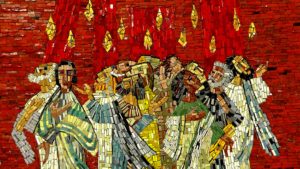Several times this week, I have heard people note the fact that we are coming up to Pentecost. But what is Pentecost? What are we actually celebrating at Pentecost?
Before Jesus’ ascension, he told the disciples to wait in Jerusalem for the coming of the Holy Spirit. This waiting time is a period of seven weeks or 50 days from Passover on the Jewish calendar. Passover was around the time when Jesus was crucified. Just as it happened at Passover, Jerusalem would have been crowded with many people gathered for the culmination of this 50-day period. The festival was called Shavuot or the “Feast of Weeks” in Hebrew or Pentecost (derived from the number 50) in Greek.
In the Jewish tradition already in Jesus’ day, there was a spiritual meaning attached to what started out in the Biblical record as a harvest festival. Shavuot celebrated first the wheat harvest, but then came to also celebrate the giving of the Torah (commonly translated as “Law” but probably better translated as “Word”) on Mount Sinai. Thus, in the space of 50 days, Israel celebrated their total salvation experience. At Passover, they celebrated their rescue from slavery in Egypt, and at Shavuot, they celebrated the giving of the Torah. God’s salvation culminated in the Torah, God’s gift which actually formed God’s people out of this rag-tag band of slaves. The Law formed the basis for truly being a people, a community under God’s rule.
The rest of the Old Testament is the story of how Israel forgot God’s Torah, dabbled in the religious practices of their neighbors, and substituted a human king and a political kingdom as the basis of their common life. While the prophets kept calling them back to the Torah, many prophets also recognized that it was not the letter of the Law that was going to save the community. They anticipated a new day in which Torah Law, that is, God’s way of structuring community, would be internalized or “written on their hearts.” They also anticipated a day when there would be a greater reality than just a political kingdom, when God would use the faithful of Israel to be a light to all nations.
Jesus preached that this new kind of “Kingdom of God” was being fulfilled in himself and the works that God was doing through him. And yet, even his closest disciples didn’t quite understand. Their parting words to Jesus were, “Lord, is this the time when you will restore the kingdom to Israel?” (Acts 1:6 NRSV) They were still thinking of a military-style secular kingdom, but Jesus made it clear that they would receive power by the Holy Spirit to be “witnesses” even “to the ends of the earth.” (Acts 1:8) This movement of God went well beyond the bloodlines of the descendants of Abraham, Isaac, and Jacob.
Indeed, Jesus’ words were fulfilled on the festival day that we now celebrate as Pentecost. And, the author, Luke, makes these events clearer in meaning by referring to both the Exodus experience (as in fire, wind, and tongues) as well as his earlier account of the birth of Jesus. In Luke 1:35, “…the angel said to [Mary], ‘The Holy Spirit will come upon you, and the power of the Most High will overshadow you; therefore the child to be born will be holy; he will be called Son of God.’” This is the power of the Spirit for the physical birth of Jesus. In turn, Jesus tells his disciples (Acts 1:8) “But you will receive power when the Holy Spirit has come upon you; and you will be my witnesses…”
Here then is a picture of the birth of the spiritual body of Christ, the church. This is not “church” in the sense that we most often use the word today. It says nothing about buildings or gatherings or even styles of worship. Instead, it has to do with how a community of God’s people structures their life together. This new community of God’s people is structured around the “Torah” (Word) made flesh in Jesus. Jesus’ self-sacrificing love was witnessed by the disciples. And the Holy Spirit of God empowered these ordinary folks to truly live together in that same self-sacrificing love. Just as at Sinai, now in Jerusalem, the Spirit takes a rag-tag bunch of (spiritual) slaves and turns them into a powerful spiritual movement to every tribe and tongue and nation. The church is formed as the spiritual body of Christ just as Mary gave birth to the physical body of Christ. And the example of Jesus’ self-giving love becomes the basis for community life rather than a written code. At Pentecost, the church is born as the spiritual Body of Christ, empowered by the Holy Spirit to live out God’s self-giving love. That love was fully shown in the physically embodied Jesus who lived and died and rose for all people in all time in a broken and sick and fearful world. May we be that church as we live out Christ’s life in the time and place to which we have been called.
For more reading on the birth of Christ's spiritual body, see this book: C. Norman Kraus. The Community of the Spirit: How the Church Is in the World. Copyright 1993 by Herald Press. Republished by Wipf and Stock.
